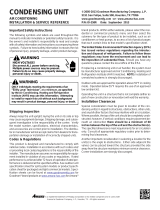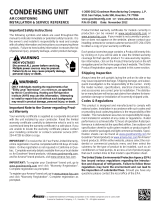
Page 6 IM-800
LOCATION
If unit is to be located under an overhang, there should be a
minimum of 36” clearance and provisions made to deflect the
water discharge air out from the overhang. If the outdoor unit
is mounted above the air handler, the maximum lift should not
exceed 70’ (suction line). If the air handler is mounted above
condensing unit, the lift should not exceed 50’ (liquid line.).
Refer to Figure 3 and Table 2 for maximum refrigerant line
lenghts.
Figure 3. Maximum Refrigerant Line Lengths
Table 2: Maximum Refrigerant Line Lengths
* 7/8" required for full ratings
** 1 1/8" required for full ratings
The condensing unit must be mounted on a solid, level founda-
tion (i.e. pre-formed concrete slab or other suitable base). For
rooftop application, verify that the building construction can
support the weight and that proper consideration is given to the
weather-tight integrity of the roof. The condensing unit con-
tains moving components and can vibrate. Therefore, sound is
also a consideration in rooftop application. Since this unit dis-
charges warm condenser air from the top with cooler air being
drawn in three sides, plantings can be made in relatively close
proximity to the unit. However, debris on the fan coil surface
reduces product efficiency. Avoid lawn mower discharge
toward the unit.
ELECTRICAL
Electrical installation will consist of power supply wiring to
the condensing unit, as well as control wiring between thermo-
stat, indoor unit and the condensing unit as shown on wiring
diagram. All wiring must be in accordance with National
Electrical Code and/or local codes that may apply.
The condensing unit rating plate lists pertinent electrical data
necessary for the selection of proper size electrical service and
over-current protection. The installer should make the owner
familiar with the location of the over-current protection, the
proper size for this application, and the proper procedure for
disconnecting power service to the unit.
The condensing unit control wiring requires a 24 Volt mini-
mum 25 VA service from the indoor transformer as shown on
the wiring diagram.
REFRIGERANT TUBING
Use only refrigerant grade (dehydrated and sealed) copper tub-
ing of the size indicated in Table 1 to interconnect the condens-
ing unit with the indoor evaporator. Take extreme care to keep
the refrigerant tubing clean and dry prior to and during instal-
lation.
Do not remove plugs from ends of tubing until connection is
ready to be made. Suction line insulation is necessary to pre-
vent condensation from forming on and dropping from suc-
tion line. Generally 3/8" wall thickness of Armflex or
equivalent is satisfactory. In severe applications (hot, high
humidity areas) greater thickness may be required. Apply suc-
tion line insulation by sliding it on the sealed tubing before
cutting and making connections.
EVAPORATOR COIL
Suction and liquid lines are under pressure. Point lines away
from persons and obects that can be damaged. Use extreme
care when removing caps. Use fittings on the liquid line to
remove pressure.
Do not remove caps until installation is complete and final
connections are to be made.
Field Connection to the Valve and Valve Opening
1. Cut tubing square. Make sure it is round and free of burrs
at the connecting ends. Clean the tubing to prevent con-
taminants from entering the system.
2. Wrap a wet rag around the copper valve stub before braz-
ing.
3. Braze or silver solder the joint.
4. After brazing, quench with a wet rag to cool the joint.
Evacuate and charge the connecting lines as outlined in this
manual.
5. Remove the valve top cap. It is important to keep the cap
in a clean area to provide proper sealing once replaced.
6. Using a standard L shaped Allen wrench, break open the
valve body. To expedite opening the valve body after it is
broken, use a ratchet wrench with a short Allen stub.
Please note that it is normal to see oil on the valve stem
body once the cap is removed.
7. Replace the valve cap and tighten with a wrench, making
sure that the the cap is sealed.
REFRIGERANT LINE LENGTH (Ft)
Cond
Unit
Tons
0-24 25-49 50-74***
Line Diameter (In. OD)
Suct Liq Suct Liq Suct Liq
1 1/2 5/8 1/4 3/4 3/8 3/4 3/8
2 5/8 1/4 3/4* 3/8 3/4 3/8
2 1/2 3/4 3/8 3/4** 3/8 7/8 3/8
3 3/4 3/8 3/4** 3/8 7/8 3/8
3 1/2 3/4 3/8 7/8** 3/8 1 1/8 3/8
4 7/8 3/8 1 1/8 3/8 1 1/8 3/8
5 7/8 3/8 1 1/8 3/8 1 1/8 3/8
CONDENSING UNIT
PITCH SUCTION LINE TOWARD OUTDOOR
UNIT 1/2" FOR EVERY 10' OF LINE
EVAPORATOR BLOWER
LIQUID LINE
CONDENSING UNIT
EVAPORATOR BLOWER
70' MAX
ADDITIONAL SUCTION LINE OIL
TRAP FOR EACH 20' RISE OF PIPE
LIQUID LINE
SUCTION LINE OIL TRAPS WHEN INDOOR UNIT
IS 4 FEET OR MORE BELOW OUTDOOR UNIT
CONDENSING UNIT
EVAPORATOR BLOWER
LIQUID LINE
SUCTION LINE
INVERTED LOOP
50' MAX
8'















